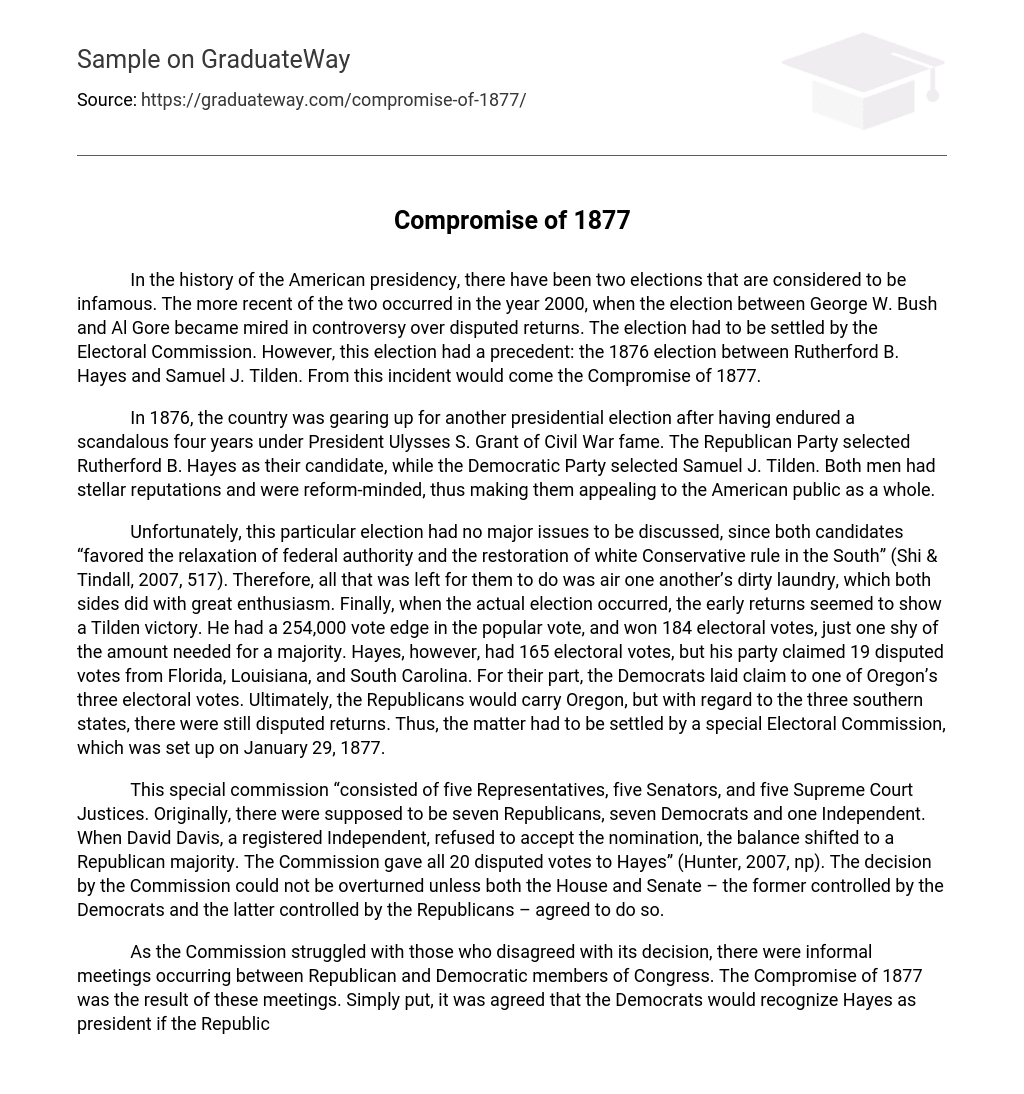In the history of the American presidency, there have been two elections that are considered to be infamous. The more recent of the two occurred in the year 2000, when the election between George W. Bush and Al Gore became mired in controversy over disputed returns. The election had to be settled by the Electoral Commission. However, this election had a precedent: the 1876 election between Rutherford B. Hayes and Samuel J. Tilden. From this incident would come the Compromise of 1877.
In 1876, the country was gearing up for another presidential election after having endured a scandalous four years under President Ulysses S. Grant of Civil War fame. The Republican Party selected Rutherford B. Hayes as their candidate, while the Democratic Party selected Samuel J. Tilden. Both men had stellar reputations and were reform-minded, thus making them appealing to the American public as a whole.
Unfortunately, this particular election had no major issues to be discussed, since both candidates “favored the relaxation of federal authority and the restoration of white Conservative rule in the South” (Shi & Tindall, 2007, 517). Therefore, all that was left for them to do was air one another’s dirty laundry, which both sides did with great enthusiasm. Finally, when the actual election occurred, the early returns seemed to show a Tilden victory. He had a 254,000 vote edge in the popular vote, and won 184 electoral votes, just one shy of the amount needed for a majority. Hayes, however, had 165 electoral votes, but his party claimed 19 disputed votes from Florida, Louisiana, and South Carolina. For their part, the Democrats laid claim to one of Oregon’s three electoral votes. Ultimately, the Republicans would carry Oregon, but with regard to the three southern states, there were still disputed returns. Thus, the matter had to be settled by a special Electoral Commission, which was set up on January 29, 1877.
This special commission “consisted of five Representatives, five Senators, and five Supreme Court Justices. Originally, there were supposed to be seven Republicans, seven Democrats and one Independent. When David Davis, a registered Independent, refused to accept the nomination, the balance shifted to a Republican majority. The Commission gave all 20 disputed votes to Hayes” (Hunter, 2007, np). The decision by the Commission could not be overturned unless both the House and Senate – the former controlled by the Democrats and the latter controlled by the Republicans – agreed to do so.
As the Commission struggled with those who disagreed with its decision, there were informal meetings occurring between Republican and Democratic members of Congress. The Compromise of 1877 was the result of these meetings. Simply put, it was agreed that the Democrats would recognize Hayes as president if the Republicans did the following: remove all federal troops still in the southern states; appoint one southern Democrat to Hayes’ administration; construct a second transcontinental railroad in the South; and enact legislation designed to promote the industrialization of the South. As with all informal dealings, however, not all aspects were enforced once Hayes got into office. Nevertheless, there was one good thing that came of the whole episode: the passage of the Electoral Count Act in 1887, which stated that it was up to the individual state to resolve a disputed count. The fact remains, however, that the “Republican Reconstruction governors stole the election, and there was nothing unconstitutional about it” (Sarles, Lesson 4, np).
Works Cited
Hunter, Kevin. The Compromise of 1877.
http://www.compromiseof1877.com/info/info.htm, 2007
Sarles, John. “Lesson 4.” History 1321, UIW.
Shi, David Emory & Tindall, George Brown. America: A Narrative History. (7th ed.) New York: W. W. Norton & Company, 2007





